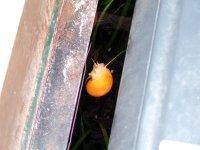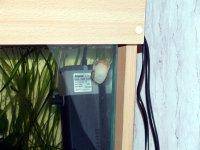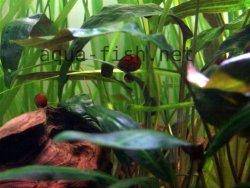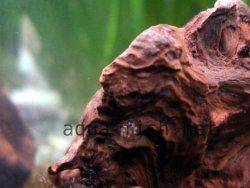Freshwater Aquarium Snails: Complete Guide to Care, Types & Population Control
Quick Links - Answers
Brief Description
Freshwater aquarium snails can be both beneficial and problematic. They help clean algae and debris but can also overpopulate quickly. This guide provides an overview of common snail species, their care, and how to manage their population effectively.
Introduction to Aquarium Snails
Aquarium snails belong to the gastropod class of mollusks, meaning they have a single, spiral-shaped shell that grows as they mature. Some species use gills to breathe, while others have lungs. Their shells, made of calcium carbonate, require a diet rich in calcium to remain strong.
Snails can be introduced intentionally or accidentally into aquariums. While some species contribute to a clean environment by consuming algae and detritus, others can become invasive and damage plants.
Common Types of Freshwater Aquarium Snails
Apple Snails (Ampullariidae)
Apple Snails are one of the most common aquarium snails. They can grow up to 6 inches (15 cm) and come in various colors, including yellow, blue, and brown. They have both gills and lungs, allowing them to breathe underwater and at the surface.
This group of snails includes the well-known Apple Snails, which have gained popularity in the aquarium hobby due to the wide variety of shell colorations available. Their striking appearance and interesting behaviors make them a favorite among snail enthusiasts.
Apple Snails are mostly nocturnal, meaning they are most active after the aquarium lights go out. They begin searching for food and can move surprisingly fast around the tank. Due to their ability to survive out of water, a tight-fitting lid is essential to prevent escapes. Some species lay their eggs above the waterline, and it is not uncommon for keepers of open-top aquariums to find their Apple Snails on the floor after falling from the tank.
The Golden Apple Snail (Pomacea bridgesii) is one of the most well-known members of this group. These snails are available in various shell colors, including Pearl, Blue, and Brown, and many aquarists note that each Apple Snail exhibits a unique personality. Unlike the closely related Pomacea canaliculata, which is considered invasive and aggressively consumes live plants, P. bridgesii is generally plant-safe as it primarily feeds on algae and decaying matter. This makes P. bridgesii a preferred choice for aquariums with live plants.
Apple Snails possess a unique advantage in their dual respiratory system. They have both gills and a primitive lung, allowing them to extract oxygen from both water and air. When keeping these snails, it is advisable to leave a 2-3 inch (5-7 cm) gap between the water surface and the lid to ensure they can breathe properly. Their breathing mechanism includes a long siphon tube, which extends from their body to the water surface, creating a fascinating display.
Unlike some snail species, Apple Snails reproduce sexually, meaning there are distinct males and females. To determine their sex, gently turn the snail upside down and examine the mantle. Males have a visible penis located just in front of their gills, while females lack this structure. Some species lay their eggs above the waterline, while others deposit them below the waterline. Regardless of placement, their eggs are typically laid in clumps and hatch after 2-3 weeks, depending on water temperature.
Pros:
- Good algae eaters, helping to maintain a cleaner tank.
- Attractive shell colors and unique personality traits.
- Can breathe both underwater and at the surface.
Cons:
- Can eat live plants if underfed.
- Requires a secure tank lid to prevent escapes.
- Some species lay eggs above the waterline, which may be difficult to remove.
Vivipariidae (Trapdoor Snails)
Vivipariidae snails differ from Ampullariidae (Apple Snails) as they do not possess lungs and must remain submerged at all times. One of their most distinctive traits is their trapdoor-like operculum, a cartilaginous cover that allows them to seal themselves inside their shell when threatened, offering strong protection against predators.
Unlike many other aquarium snails, species from this group give birth to live young, which reduces the chances of their offspring being eaten by other tank inhabitants. However, not all Vivipariidae species are truly live-bearing; some lay eggs that hatch just before the young emerge, making their reproductive strategy unique compared to other snail families. Their breeding rate is generally slower than that of egg-laying snails, making them less likely to overpopulate a tank.
Vivipariidae snails are highly beneficial for aquarium and pond ecosystems, as they primarily consume algal deposits rather than live plants. This makes them an excellent addition to planted tanks where excessive algae growth is an issue. They are particularly valuable in outdoor ponds, where they help control algae levels during the warmer months.
One of the most well-known species in this group is the Chinese Mystery Snail (Cipangopaludina chinensis), which comes in a variety of shell colors and patterns. These snails are known for their long lifespan, often outliving many other aquarium snail species. However, in some regions, C. chinensis is considered an invasive species, as it can rapidly establish itself in natural water systems and disrupt local ecosystems. Therefore, hobbyists should ensure responsible ownership and avoid releasing them into the wild.
Pros:
- Non-invasive, as they reproduce at a slower rate compared to egg-laying snails.
- Excellent algae eaters, particularly useful in ponds.
- Do not consume live plants, making them ideal for planted aquariums.
- Protected by a trapdoor-like operculum, reducing predation risk.
Cons:
- Some species require colder water temperatures, limiting their compatibility with tropical fish tanks.
- Can be sensitive to poor water quality, requiring well-maintained aquariums.
Ramshorn Snails (Planorbidae)
Named for their coiled shell, Ramshorn Snails reproduce quickly and can become pests in some aquariums. They primarily feed on algae but may consume live plants if food is scarce.
Pros: Effective algae eaters.
Cons: Rapid reproduction can lead to overpopulation.
Trumpet Snails (Thiaridae)
The gem of the aquarium snail scene is the Malayan live-bearing snail, also known as the Malaysian Trumpet Snail (Melanoides tuberculata). This brown snail with red spots has a very pointed spiral shell and thrives on consuming scraps of fish food and debris. Unlike some pest snails, their nocturnal behavior and tendency to burrow into the substrate make them far less intrusive in an aquarium.
Trumpet Snails play a crucial role in substrate aeration. They dig into the gravel or sand during the day and emerge at night to feed, preventing the buildup of anaerobic pockets that can release harmful gases into the aquarium. Their ability to sift through detritus makes them highly beneficial for maintaining a healthy tank ecosystem.
These snails are live-bearers and can produce up to 70 offspring at a time. While their population growth can be controlled by limiting excess food, they are still known for their rapid reproduction. Since they spend most of their time hidden beneath the substrate, they rarely become a visual nuisance.
Pros:
- Excellent at aerating the substrate and preventing gas buildup.
- Consumes uneaten food and detritus, helping maintain water quality.
- Nocturnal behavior makes them less obtrusive in the aquarium.
Cons:
- Can multiply quickly if overfed.
- Burrowing behavior may disturb delicate rooted plants.
Nerite Snails (Neritidae)
Nerite Snails are highly effective algae eaters and do not reproduce in freshwater, making them an excellent choice for planted tanks. They are widely appreciated for their unique, tear-drop-shaped shells and their ability to thrive in different water conditions.
These snails can inhabit freshwater, brackish, and saltwater environments. While they lay eggs in freshwater, the larvae require brackish water to develop, which prevents them from overpopulating an aquarium. Some species, such as Theodoxus fluviatilis, are particularly well-adapted to mildly brackish conditions, allowing them to survive in a range of aquatic environments.
Nerites are relatively small compared to other snail species, usually reaching around 1 inch (2.5 cm) in size. They come in a variety of colors and patterns, including zebra stripes, spotted patterns, and solid colors, making them visually appealing additions to aquariums.
One challenge with keeping Nerite Snails is that they frequently lay eggs, which can be difficult to remove. These eggs do not hatch in freshwater but may still stick to glass, decorations, or driftwood, sometimes giving tanks an unwanted appearance. The eggs are particularly resilient and can persist for a long time, making them a potential aesthetic concern for some aquarists. Regular cleaning and scraping of decorations may be necessary to maintain a clean look.
Pros:
- Excellent for algae control – they consume even stubborn types of algae like green spot algae.
- Do not reproduce in freshwater, preventing overpopulation issues.
- Attractive variety of shell colors and patterns.
- Suitable for planted tanks as they do not damage healthy plants.
Cons:
- Lay hard-to-remove eggs that may persist on decorations.
- Can be sensitive to low calcium levels, which may lead to shell erosion.
- Short lifespan – typically live 1-2 years in optimal conditions.
How to Care for Aquarium Snails
- Water Parameters: Maintain a calcium-rich, slightly hard water environment. Hard water is particularly important for Neritidae, Ampullariidae, and Vivipariidae, as it helps prevent shell erosion and softening.
- Temperature: Most species thrive at 22-28°C (72-82°F), but some Vivipariidae species, such as Cipangopaludina chinensis, prefer cooler water conditions of around 18-24°C (64-75°F).
- Diet: Feed vegetables like cucumber and zucchini, along with algae and fish food scraps.
- Filtration: Use a high-quality filter to prevent ammonia buildup.
How to Control Aquarium Snail Populations
- Remove excess food: Overfeeding fish leads to more food for snails.
- Manual removal: Use a plate with food at night to trap snails.
- Predators: Fish like Clown Loaches help control snail populations. However, Clown Loaches (Chromobotia macracanthus) grow quite large, reaching over 30 cm (12 inches) in length, making them unsuitable for smaller tanks. A better alternative for smaller aquariums includes Zebra Loach (Botia striata) or Yoyo Loach (Botia almorhae), both of which are effective snail predators while remaining more manageable in size.
- Quarantine new plants: Prevent snail infestations by rinsing plants before introducing them to the tank.
Frequently Asked Questions
Why do aquarium snails seal themselves in their shells?
They do this for protection against predators or when stressed. This survival mechanism helps them conserve moisture and energy in case of sudden changes in their environment.
Why have I got shells appearing on my tank glass?
This likely indicates an outbreak of baby snails, which were probably introduced to your tank via plants or transferred substrate.
What do snails need to live happily?
Snails are generally hardy and adaptable, but they require water with sufficient calcium levels to maintain strong shells. A well-balanced diet and stable water conditions also contribute to their health.
Where do some smaller aquarium snails come from?
If you didn't intentionally introduce snails, they likely came as hitchhikers on live plants. To prevent unwanted snails, rinse and quarantine new plants before adding them to your tank.
Where can I buy Ramshorn snails online?
Ramshorn snails can often be purchased from online aquarium retailers. Availability varies, so check with your preferred supplier for current stock.
Which snails become pests in the aquarium?
Any snail species can become a pest if they reproduce unchecked. Overfeeding fish results in excess food, which supports uncontrolled snail populations.
What can I do if my freshwater snail has air in its shell?
Snails may sometimes trap air in their shells, causing them to float. This issue typically resolves itself as the snail expels the air naturally.
Which aquatic snails are hermaphroditic?
Pond and Ramshorn snails are the most common hermaphroditic species, meaning they can reproduce without a mate. Apple snails, however, require both a male and a female to breed.
What should I use to treat digenetic flukes?
There is currently no effective treatment for digenetic flukes in snails. The best prevention is to avoid introducing potentially infected snails into your tank.
What do you feed aquatic snails?
Snails thrive on a diet of algae, fish food, vegetables like zucchini and spinach, and calcium supplements to support shell health. Some snails, like Nerite snails, require a steady source of algae.
How do I get rid of snails in my aquarium?
Use food traps, introduce natural predators, or manually remove them. Reducing excess food in the tank also helps control their population.
Which snails are best for algae control?
Nerite Snails and Malaysian Trumpet Snails are among the most effective algae eaters.
Can aquarium snails live with shrimp?
Yes, most freshwater snails are compatible with shrimp, as they are peaceful and help clean up excess food without posing a threat.
Do aquarium snails clean fish waste?
Not entirely. While they help break down leftover food and detritus, they do not consume fish excrement directly. However, by feeding on uneaten food and biofilm, they indirectly contribute to maintaining cleaner water conditions in the aquarium.
What is the best way to prevent snail overpopulation?
Avoid overfeeding your fish, manually remove excess snails, and quarantine new plants to prevent hitchhiker snails.










